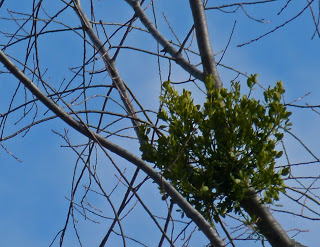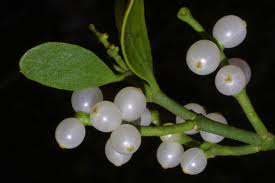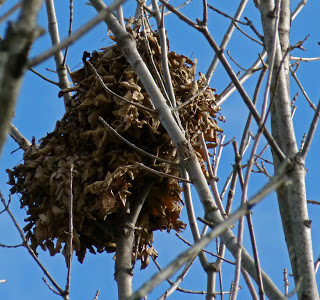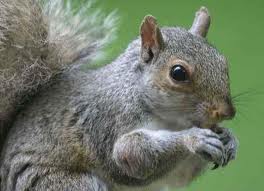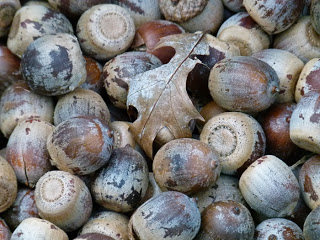Now that the tree branches are bare, you may notice dark blobs in the branches and wonder what in the world they are. Here in Kentucky, there are two options to choose from – either mistletoe or squirrel nests. It’s easy to tell them apart, since you can see sky through the branches of mistletoe and if the light is good the green leaves are clearly visible.
The word “mistletoe” is derived from the Anglo-Saxon words, “mistel” (dung) and “tan” (twig) — misteltan is the Old English version of mistletoe. It’s thought that the plant is named after bird droppings on a branch. People used to believe that, rather than just passing through birds in the form of seeds, the mistletoe plant was an inherent result of birds landing in the branches of trees. The birds also help spread the seed by wiping their beaks on the tree bark to clean off the sticky seeds after they’ve eaten. The seeds are sticky because of the juice inside the berry, which helps the seeds stay in the tree rather than falling to the ground. Within six weeks, the mistletoe plant begins growing, although it takes five years to flower.
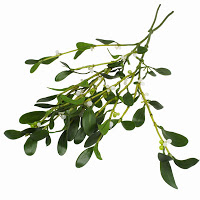 Mistletoe (Phoradendron flavescens or Viscum album) is a parasitic plant that grows on trees, particularly hardwood trees like oak and apple. A parasite is a plant or animal that needs another plant or animal to survive. As mistletoe grows on a tree its roots invade a tree’s bark, which allows mistletoe to absorb the tree’s nutrients. Sometimes, mistletoe can harm a tree and cause deformities in a tree’s branches, but usually it doesn’t kill its host. If the host dies, the mistletoe dies. Mistletoe produces its own food by photosynthesis and is able to live on its own, although it is mostly found in trees.
Mistletoe (Phoradendron flavescens or Viscum album) is a parasitic plant that grows on trees, particularly hardwood trees like oak and apple. A parasite is a plant or animal that needs another plant or animal to survive. As mistletoe grows on a tree its roots invade a tree’s bark, which allows mistletoe to absorb the tree’s nutrients. Sometimes, mistletoe can harm a tree and cause deformities in a tree’s branches, but usually it doesn’t kill its host. If the host dies, the mistletoe dies. Mistletoe produces its own food by photosynthesis and is able to live on its own, although it is mostly found in trees.
The dark colored solid blob probably belongs to a squirrel. When I teach classes at the Nature Preserve about animals who live in trees, children often expect squirrels to live in a cavity in the tree trunk, when actually they build nests of leaves between sturdy branches. Do squirrels hibernate in winter? No, they stay in their nests to conserve body heat in cold weather, but are active all year. In fact, squirrels mate in the late Winter or very early Spring. This time may vary with location, and the weather conditions. The best time to see a squirrel’s acrobatic skill is, during the “mating chase”.
Most squirrels eat nuts, seeds, grain, and fruit. By far their favorite food would be nuts, followed by sunflower seeds. Urban squirrel have adapted to eat just about anything, including pizza, luncheon meats and all forms of snack foods. Squirrels have been known to eat bird eggs, but this is a last resort. Gray and Fox squirrels hide their food in many places, so if another squirrel or animal were to find it, the entire year’s supply would not be lost. Sometimes they hide food temporarily, until they can move it to a more convenient location. This is called “scatter hoarding”. Of course, squirrels help plant trees when they do not eat all the buried acorns.

